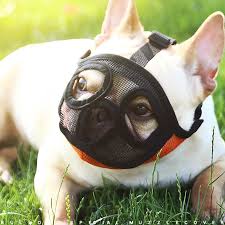French Bulldog Muzzle are known not only for their personality but also for their chubby face and characteristic bat ears. However, it cannot be denied that dogs such as French Bulldogs have some peculiarities of their own, the most important of which is their brachycephalic skull profile. Knowing about the muzzle of French Bulldogs is essential for the prevention of health problems and the comfort and well-being of the dog as a whole.
French Bulldog Muzzle mouth structure
The buzzing of the French Bulldog’s pushy nose is one of the characteristic features of the breed. French Bulldogs have a brachycephalic skull shape, which means they have a short and broad muzzle, unlike other dog breeds that have a prominent muzzle. This Beast feature also presented significant challenges and benefits. As with other typical breeds, its variation has a number of advantages and disadvantages.
The structure of his body here is protruding in such a way that the mucous structures collapse easily, but normal breathing becomes a problem. These serve only for other craniofacial syndromic distortions. Extended outlet aspiration – wall suturing of symptoms such as obstructive sleep apnea, brachycephalic obstructive beau syndrome accretion sable.
French Bulldogs have shallow nostrils and a long soft palate, so airflow is further compromised. Due to this unique structure, these dogs are at a higher risk of overheating because they cannot cool themselves by breathing efficiently like other dogs. It is essential for pet owners who want to breed French Bulldogs to understand these parts of the mouth to ensure proper control and avoid cases of health-related inaccuracies.
Why should you ever consider a muzzle for your French Bulldog?
The idea of a muzzle can be very uncomfortable and even seen as an act of cruelty. However, there are times, especially in the case of French Bulldogs, when it can be considered a handy device. The use of muzzles can help limit unnecessary activities, restrain the animal and prevent injuries during visits to the vet or stop inappropriate behavior in many stressful situations. Like any other dog breed, French Bulldogs can become aggressive in fearful or exciting situations. A muzzle can be used to control this type of behaviour without using force and risking injury.

Muzzles can also be helpful in cases where your French Bulldog Muzzle needs to be brushed,, and nail clipping or clean ears are other routines they don’t like. It allows the groomer to achieve a higher level of efficiency without causing stress to the dog. Additionally, in places where there are leash laws, a muzzle would be an added advantage as it will assist the owner in controlling the French Bulldog Muzzle from aggressive behaviour towards other dogs and people.
Types of Muzzles for French Bulldogs
It goes without saying that choosing the fitting muzzle for your French Bulldog Muzzle is the very first thing you should do if you want your French Bulldog Muzzle to be safe and healthy. Depending on the intended use or even the species of dog, there are a number of types of these covering devices available for use in dogs.
Basket Muzzles: For French Bulldogs, basket muzzles are one of the most preferred options. Usually made of durable materials that include either plastic or metal, the dog can also breathe, drink water, and feed itself small treats while riding the sledge. The frame of the basket offers comfort because it does not cut the nose of the French Bulldog Muzzle that is in the basket. It is best suited for long-term use, such as for walks or visits to the vet.
Soft Muzzles: These types of muzzles usually consist of a piece of material or mesh and surround the dog’s mouth. However, they are light and less cumbersome. However, these are less ideal for more extended periods as they restrict your French Bulldog Muzzle from panting or drinking. These muzzles are best used for shorter periods, such as during the grooming process or very short trips to the veterinary clinic.
Short Muzzle: Otherwise known as short muzzle, they are made mainly for brachycephalic dogs such as French Bulldogs. Such products cover almost the entire face but not the nostrils and mouth. These masks cover all the wiped areas but have a gap around the mouth and nose to prevent airway obstruction. Most of them have lovely suspensions on them,, and this helps a lot for those French bulldogs with very short muzzles.
When it comes to the muzzle, you need to focus on the needs of your French Bulldog. The correct muzzle is essential, as a muzzle that is tight and ill-fitting can cause pain or injury to the dog. Take adequate measurements of your dog’s muzzle and choose a muzzle that still allows movement and normal breathing.
Teach your French Bulldog Muzzle to wear a muzzle.
If you want to introduce the muzzle to your French body, the first stage is to start on the muzzle and panic so that the muzzle does not register, and the adaptation to flattening should be progressive. It is helpful to get proper training and make it easier for you and the dog.
Do not muzzle your French Bulldog Muzzle at first, but let him touch and sniff it. Use their praise and treats to start building a positive experience with the muzzle. You can slowly begin to hold the muzzle over their nose for a few seconds and then see how it feels and how comfortable it fits. Continue to use treats and praise the two of you while he wears the muzzle, of course, building up his desire to wear it over time.
Good things take time, and when muzzle training, take it slow and don’t push the muzzle against the dog’s face. In the event that your French Bulldog Muzzle tries to resist, displays any unnatural behaviour, or exhibits attachment issues, give him a break and let him calm down. Consistency, along with positive muzzle training, will improve a successful practice.
When to Muzzle Your French Bulldog
A muzzle should be a proactive safety measure rather than a form of punishment. The muzzle management aspect also requires all handlers to know when a bulldog is to be muzzled.

A muzzle during a visit to the vet is a means of reducing stress and preventing aggressive behaviour. French bulldogs can be nervous, especially in strange places, and a muzzle is used to calm both the dog and the vet.
Outdoors in crowded areas, or even where other dogs or children are present, a muzzle can also help stop the risk of unexpected reactions. Despite the fact that French bulldogs like the company of people and do not aggressively avoid new acquaintances, there are situations when such dogs feel anxious and may react inappropriately. The muzzle simply and effectively keeps your dog under control and prevents nasty accidents.
In addition to leash training, the coats of the French Bulldog Muzzle can be another source of frustration as they are only some of the most approachable dogs. Since anticipation is always encouraged when working with an animal, the muzzle provides leverage for the handler, maximising the time needed to calm the dog.
It is worth noting at this point that muzzles should not be worn for long periods or used to solve behavioural problems. When Mukei’s French Bulldog Muzzle shows aggression, the primary step should be to solve the problem with the help of a professional dog trainer or behaviourist.
The fit and comfort of French Bulldog Muzzle
Imparting properly fitting French Bulldog Muzzle to your pets is very important to their health and well-being. The muzzle should be designed to allow the animal to drink, breathe and hyperventilate comfortably. There should not be a situation where the muzzle is less tight; this leads to trouble-free movement of the dog with the muzzle. Again, muzzle tapping should not be too intense as to restrict the dog’s airflow.
The band should also be adjusted around the muzzle, and the vertical length should be from the bottom of the nostrils to the end of the muzzle. Choose a muzzle whose circumference covers the stated limits but at the same time allows for natural facial expressions. Some come with a brand of tiara markers to customise the fittings as needed.
Make sure the muzzle is regularly adjusted to fit, especially if the French Bulldog Muzzle is still a growing puppy or if the device is worn relatively often than usual. Keeping your dog’s muzzle in proper condition will limit the impact of possible painful injuries.
Alternatives to muzzles
Muzzles are useful tools for dog training, but sometimes, they may not be appropriate in some situations. Knowing the alternatives means you can handle your French Bulldog’s behaviour without muzzles.
Instead of relying on passive restraint with muzzles, people have started using behavioural training alternatives as one of the most effective alternatives. People can seek help from a professional dog trainer or behaviourist to remove any incipient aggressive or anxious tension. Desensitisation, positive reinforcement practices, and socialisation can help minimize muzzle use in most situations.
Concept of responsible ownership
Owning a French Bulldog Muzzle comes with a burden on the owner – to care for the dog and protect it when necessary. For example, there are cases where it would be required to use a muzzle. The owner expects to know to what extent the muzzle is suitable and how it can be introduced to their pets without the device bothering them.
Need for socialization and other measures
Among other things, for reasons of muzzle consumption, the animal should be socially exposed in the shortest possible time. Children who have a number of interactions, from the French Bulldog, sociability helps to orient themselves correctly in many conditions and the likelihood of aggression or hysteria is reduced.

The emotional well-being of your French Bulldog
The use of a muzzle is something that clearly has to take into account the emotional aspect of Frenchie’s well-being. Muzzles are also a last resort for situations where problems have not been resolved and should never be relied upon as an adequate solution. Dogs that are routinely muzzled, despite not being exposed to acceptable behavior, tend to become more and more agitated, frustrated or aggressive over time.
Familiarity with the law and ethical issues
In some jurisdictions, brachycephalic breeds such as the French Bulldog Muzzle have been found to have special laws regarding the use of muzzles. You should also find out if there are dog muzzle ordinances in your area that may state that your dog should be muzzled in public places or particular situations. It is advisable to follow such laws so that you do not endanger your dog or other people and also avoid legal issues.
From an ethical point of view, when deciding to muzzle a French Bulldog, one should always consider their welfare first. Body restraints such as muzzles should never be regarded as the only response to aggression and should only be used in necessary and limited scenarios. Carefully monitor your pet’s behavior and emotions to determine if a muzzle is still needed or if other methods cannot replace it.
Conclusion: A safe approach to using muzzles
The peculiarities of the muzzle of the French Bulldog Muzzle bring both difficulties and advantages when displaying a pet. In order to take care of the French Bulldog’s health, it is essential to know how to relate to the structure of the face: First, understand the nature of the mouth; choose a suitable type of muzzle; and adequately train and socialize the dog.
This is not to say that a muzzle is not a helpful device at any time; instead, it should be used appropriately with the dog’s calm in mind. It offers a comprehensive approach to solving the problem of prevention and rehabilitation – the French Bulldog Muzzle will be safe even in the most extreme conditions, not only will it not suffer from stress, but will remain full of energy and good mood. Successful use of a muzzle ultimately depends on the owner appreciating the dog’s feelings, paying the dog the proper attention, and making the right decisions that benefit the dog.










